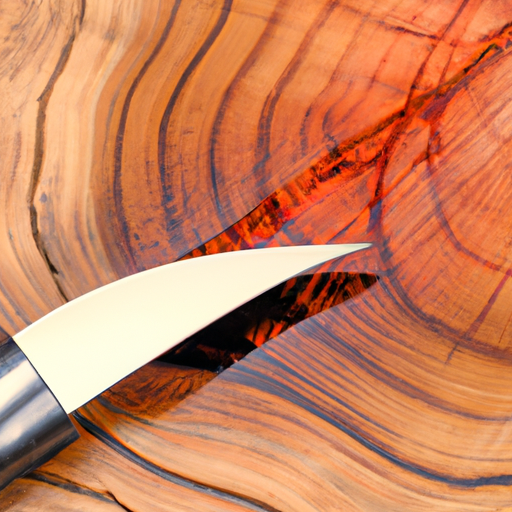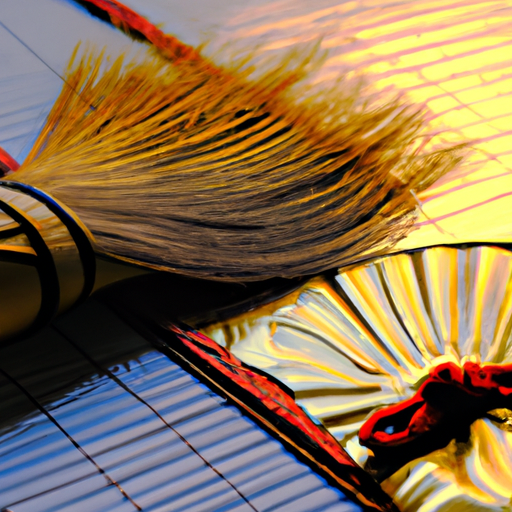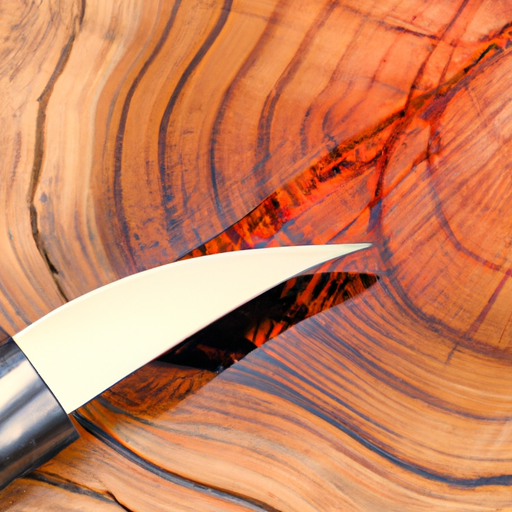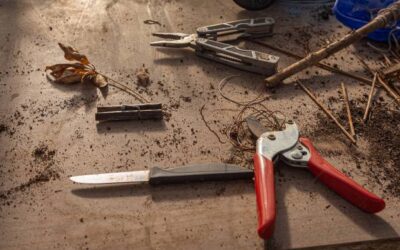In this article, you will learn about the importance of oiling in the maintenance of Japanese garden tools. Oiling plays a crucial role in keeping your tools in top condition and extending their lifespan. By regularly oiling your tools, you can prevent rust, corrosion, and wear and tear, ensuring that they remain sharp and efficient.
Oiling is especially important for Japanese garden tools as they are typically made from high-quality carbon steel. Carbon steel is known for its durability and sharpness, but it is also susceptible to rust. By applying a thin layer of oil to the metal surfaces of your tools, you create a protective barrier that prevents moisture from reaching the steel and causing corrosion. Additionally, oiling helps to keep the blades of your tools sharp by reducing friction and preventing them from getting stuck while cutting or pruning. With regular oiling, your Japanese garden tools will not only perform better but also last longer, allowing you to enjoy their benefits for years to come.

Why is Oiling Important for Japanese Garden Tools?
Japanese garden tools are known for their exceptional craftsmanship and durability. The intricate blades and handles of these tools are often made from high-quality steel and wooden materials. However, like any other tools, Japanese garden tools require proper maintenance to ensure their performance and longevity. One critical aspect of maintaining these tools is oiling. Oiling plays a crucial role in preventing rust and corrosion, enhancing performance, protecting against wear and tear, and prolonging the lifespan of Japanese garden tools.
Prevention of Rust and Corrosion
Japanese garden tools are often exposed to various environmental factors, such as moisture, humidity, and even rain. These conditions can lead to the formation of rust on the metal parts of the tools, which can cause significant damage over time. Oiling the tools creates a protective barrier on the metal surfaces, preventing moisture from coming into direct contact with the metal and preventing rust and corrosion from developing. Regular oiling helps to keep the tools in prime condition, ensuring that they remain efficient and functional.
Enhancement of Performance and Longevity
Properly maintained tools perform better and last longer. When you oil your Japanese garden tools regularly, you ensure that the blade and other moving parts of the tools are lubricated. This lubrication reduces friction and allows the tools to move smoothly. Smooth movement not only makes gardening tasks easier but also reduces the risk of damage to the tools. Additionally, oiling prevents the wooden handles from drying out and cracking, maintaining their strength and integrity over time. By investing time in oiling your tools, you are investing in their performance and long-term usability.
Protection Against Wear and Tear
Japanese garden tools, such as pruning shears, bonsai tools, hori hori knives, saws, and hatchets, are designed to withstand rigorous use. However, regular wear and tear can still affect their performance and efficiency. Oiling acts as a protective barrier against wear and tear by reducing friction and preventing the accumulation of dirt and debris on the tool surfaces. This protection ensures that your tools remain sharp, sturdy, and reliable, even after extended periods of use.
Understanding the Types of Oils for Japanese Garden Tool Maintenance
There are several types of oils that can be used for Japanese garden tool maintenance. Each oil has its own unique properties and benefits. Here are three commonly used oils:
Mineral Oil
Mineral oil is a popular choice for oiling Japanese garden tools due to its versatility and affordability. It is a clear, odorless, and lightweight oil that provides excellent lubrication and rust protection. Mineral oil is readily available and can be found in most hardware or gardening stores. It is suitable for general tool maintenance and can be used on both metal and wooden parts.
Tung Oil
Tung oil is derived from the seeds of the tung tree and has been used for centuries in Japan for various applications, including woodworking and tool maintenance. It is known for its exceptional durability and water-resistance properties, making it an ideal choice for protecting wooden handles. Tung oil penetrates deep into the wood, providing long-lasting protection against cracking, drying, and moisture damage.
Camellia Oil
Camellia oil, also known as tea seed oil, is derived from the seeds of the Camellia plant. It has been traditionally used in Japan for centuries for various purposes, including cooking and skincare. Camellia oil is known for its high smoke point, making it an excellent choice for tools that may come into contact with fire or heat. It provides a protective coating on metal surfaces, preventing rust and corrosion, while also nourishing and conditioning wooden handles.
When and How to Oil Japanese Garden Tools
Frequency and Timing of Oiling
The frequency of oiling your Japanese garden tools depends on several factors, including the type of tool, frequency of use, and environmental conditions. As a general guideline, it is recommended to oil your tools every 1 to 3 months, or whenever you notice signs of wear, rust, or dryness. Tools that are exposed to harsher conditions or used more frequently may require more frequent oiling. Additionally, it is a good practice to oil your tools before storing them for an extended period.
Step-by-Step Guide to Oiling
- Start by cleaning your tools thoroughly to remove any dirt, debris, or rust. Use a brush or cloth to gently scrub the tool surfaces.
- Apply a few drops of oil onto a clean cloth or brush. It is recommended to use a lint-free cloth or a brush with soft bristles.
- Begin applying the oil to the metal parts of the tool, focusing on areas that are prone to rust or corrosion. Ensure that the entire surface is covered with a thin, even layer of oil.
- If necessary, apply a small amount of oil to the wooden handle, rubbing it in gently to nourish and protect the wood.
- Allow the oil to penetrate and absorb into the tool surfaces for a few minutes.
- Use a clean cloth to wipe off any excess oil, ensuring that the tool is not left with a sticky or greasy residue.
- Repeat the oiling process for all your Japanese garden tools, making sure to oil both the blades and handles.
Tips for Proper Application
- Apply the oil in a well-ventilated area to avoid inhaling any fumes.
- If you are oiling multiple tools, keep track of which ones have been oiled to avoid missing any.
- Store your oiling tools separately from your gardening tools to avoid cross-contamination.
- Regularly inspect your tools for any signs of wear or damage, and address them promptly to prevent further issues.
Choosing the Right Oiling Tools
To ensure proper and effective oiling of your Japanese garden tools, it is essential to choose the right oiling tools and equipment. Here are some commonly used oiling tools:
Brushes and Applicators
A soft-bristled brush or a cloth applicator is ideal for applying oil to the metal surfaces of your tools. The brush should have flexible and gentle bristles to avoid scratching or damaging the tool surfaces. A cloth applicator allows for more control and precision during the oiling process.
Cloths and Wipes
Lint-free cloths or wipes are recommended for wiping off excess oil and ensuring a clean finish. Microfiber cloths are particularly useful as they are absorbent and gentle on the tool surfaces. Avoid using rough or abrasive materials that may scratch the metal or wood.
Other Oiling Equipment
Depending on your preference, you may also consider using oiling cans or droppers for precise oil application, especially for hard-to-reach areas or intricate parts of the tools. Additionally, having a dedicated oiling tray or container can help keep your oiling tools organized and easily accessible.

Proper Storage and Cleaning Techniques for Japanese Garden Tools
Proper storage and cleaning techniques are essential for maintaining the effectiveness and longevity of your Japanese garden tools. Here are some tips to follow:
Cleaning Before Oiling
Before oiling your tools, it is important to clean them thoroughly. Remove any dirt, debris, or rust using a brush, cloth, or mild detergent. For stubborn rust, you can use a rust remover or steel wool. Make sure to dry the tools thoroughly before applying oil to prevent moisture buildup.
Safe Storage Practices
When not in use, store your Japanese garden tools in a cool, dry place, away from direct sunlight and moisture. Hang them on a rack or store them in a clean and dry toolbox. Avoid storing tools in damp or humid areas, as this can accelerate rust formation and damage the wooden handles. Proper storage practices will help prolong the lifespan of your tools and keep them in optimal condition.
Common Mistakes to Avoid in Oiling Japanese Garden Tools
While oiling is essential for proper tool maintenance, there are some common mistakes that you should avoid to ensure the best results. These include:
Over-Oiling
Applying too much oil can lead to a sticky or greasy residue, which can attract dirt and debris. Additionally, over-oiling can make the tool surfaces slippery, reducing grip and control. Always apply a thin, even layer of oil and wipe off any excess to avoid these issues.
Using Incorrect Oils
Using the wrong type of oil can have adverse effects on your Japanese garden tools. Some oils may not provide adequate rust protection or may cause damage to the tool surfaces. Stick to the recommended oils for your specific tools or seek advice from a professional if you are unsure.
Neglecting Regular Maintenance
Regular maintenance is key to ensuring the longevity of your Japanese garden tools. Neglecting to oil your tools or skipping other maintenance tasks can result in decreased performance, increased wear and tear, and even irreparable damage. Incorporate regular maintenance into your gardening routine to keep your tools in the best possible condition.
Importance of Regular Inspection and Maintenance
Regularly inspecting and maintaining your Japanese garden tools is important for their overall performance and durability. By taking the time to inspect your tools, you can identify signs of damage or wear, address any issues promptly, and ensure that your tools remain in optimal condition. Here are some key reasons why regular inspection and maintenance are essential:
Identifying Signs of Damage or Wear
Through regular inspection, you can identify any signs of damage or wear on your tools. This may include rust formation, bent or broken blades, loose handles, or dull cutting edges. Identifying these issues early allows for timely repairs or replacements, minimizing further damage and ensuring the tools remain safe and effective.
Addressing Issues Promptly
Promptly addressing any issues or damage is crucial to prevent further deterioration of the tools. Repairing or replacing damaged parts, sharpening blades, and tightening loose handles can help restore the tools’ functionality and prolong their lifespan. Ignoring these issues can lead to more severe damage and potential safety hazards.
Sharpening and Honing Techniques
Regular maintenance includes sharpening and honing your Japanese garden tools as needed. Dull blades can make gardening tasks more difficult and can cause damage to plants. Proper sharpening and honing techniques help maintain the tools’ cutting performance and ensure clean, precise cuts. Consult the manufacturer’s guidelines or seek advice from professionals to learn the proper sharpening techniques for your specific tools.
Tips for Maintaining Different Types of Japanese Garden Tools
Different Japanese garden tools require specific maintenance techniques to ensure their optimal performance. Here are some tips for maintaining specific types of tools:
Pruning Shears
After each use, wipe the blades clean to remove any sap or debris. Apply a few drops of oil to the pivot point and other metal surfaces of the shears. Ensure that the blades are properly aligned and sharpened regularly to maintain their cutting efficiency.
Bonsai Tools
Bonsai tools require special care due to their delicate nature. Clean the tools after each use and oil them regularly to prevent rust. Use a bonsai oil or a light machine oil for this purpose. Sharpen and sterilize the cutting edges as needed to ensure precise and clean cuts on your bonsai trees.
Hori Hori Knives
Hori hori knives are versatile tools often used for digging, cutting, and weeding. Clean the blades thoroughly after each use and apply oil to prevent rust. Sharpen the cutting edge periodically to maintain its sharpness and effectiveness.
Saws and Hatchets
Clean saws and hatchets after each use to remove sap, resin, and other debris. Apply oil to the blade and teeth to prevent rust formation. Regularly inspect the cutting edges and sharpen them as needed to ensure clean and efficient cutting.
Alternative Methods and Natural Products for Garden Tool Maintenance
While commercially available oils are effective for tool maintenance, there are also alternative methods and natural products that can be used. These options provide eco-friendly alternatives and may have additional benefits. Here are a few examples:
Eco-Friendly Oiling Options
- Beeswax: Beeswax can be melted and applied to the wooden handles to provide moisture resistance and protection.
- Coconut Oil: Coconut oil can be used as a natural lubricant for metal parts, providing rust protection.
- Citrus Extracts: Citrus extracts can be mixed with water to create a natural cleaning solution for tool maintenance.
Homemade Oiling Solutions
- DIY Oiling Blend: Mix equal parts of mineral oil, beeswax, and melted coconut oil to create a homemade oiling solution that provides both lubrication and protection.
- Vinegar Solution: Mix equal parts of vinegar and water to create a natural cleaning solution for removing rust or other stains on tool surfaces.
When opting for alternative methods or natural products, it is important to research and ensure that they are suitable for your specific tools and maintenance needs.
Conclusion
Oiling plays a crucial role in maintaining the performance and longevity of Japanese garden tools. By preventing rust and corrosion, enhancing performance, and protecting against wear and tear, oiling ensures that your tools remain reliable and efficient. Understanding the different types of oils and their properties allows you to choose the right oil for your specific tools. Following proper oiling techniques, using the appropriate maintenance tools, and incorporating regular inspections and maintenance into your gardening routine are essential for keeping your Japanese garden tools in prime condition. By prioritizing tool maintenance and addressing issues promptly, you can enjoy the benefits of well-maintained tools for years to come.








